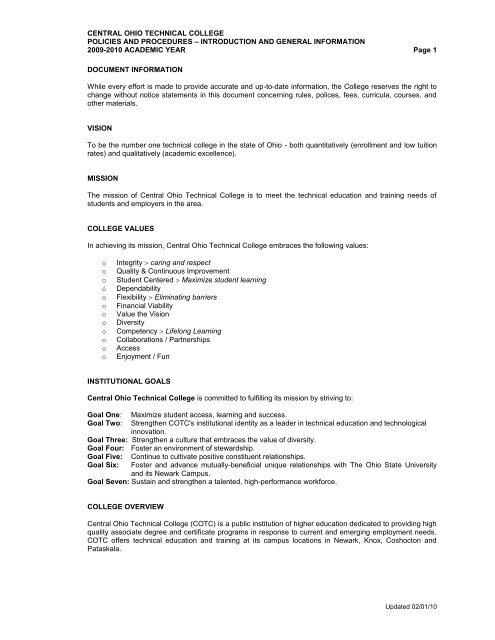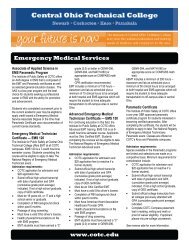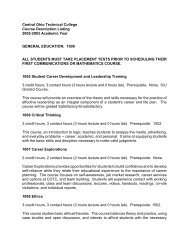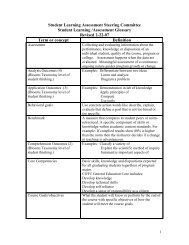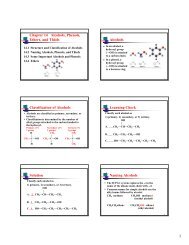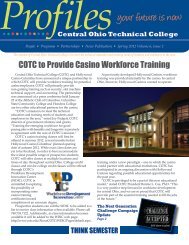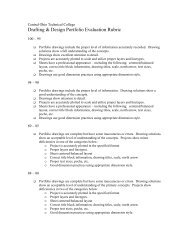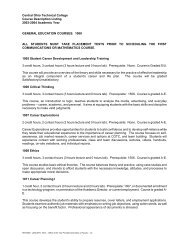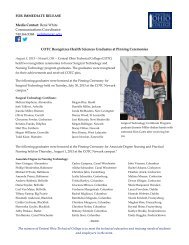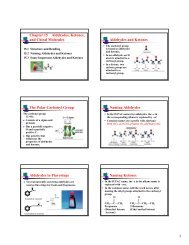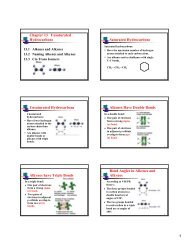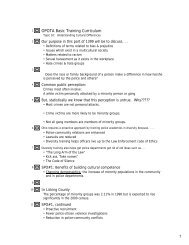Central Ohio Technical College
Central Ohio Technical College
Central Ohio Technical College
Create successful ePaper yourself
Turn your PDF publications into a flip-book with our unique Google optimized e-Paper software.
CENTRAL OHIO TECHNICAL COLLEGE<br />
POLICIES AND PROCEDURES – INTRODUCTION AND GENERAL INFORMATION<br />
2009-2010 ACADEMIC YEAR Page 1<br />
DOCUMENT INFORMATION<br />
While every effort is made to provide accurate and up-to-date information, the <strong>College</strong> reserves the right to<br />
change without notice statements in this document concerning rules, polices, fees, curricula, courses, and<br />
other materials.<br />
VISION<br />
To be the number one technical college in the state of <strong>Ohio</strong> - both quantitatively (enrollment and low tuition<br />
rates) and qualitatively (academic excellence).<br />
MISSION<br />
The mission of <strong>Central</strong> <strong>Ohio</strong> <strong>Technical</strong> <strong>College</strong> is to meet the technical education and training needs of<br />
students and employers in the area.<br />
COLLEGE VALUES<br />
In achieving its mission, <strong>Central</strong> <strong>Ohio</strong> <strong>Technical</strong> <strong>College</strong> embraces the following values:<br />
o Integrity caring and respect<br />
o Quality & Continuous Improvement<br />
o Student Centered Maximize student learning<br />
o Dependability<br />
o Flexibility Eliminating barriers<br />
o Financial Viability<br />
o Value the Vision<br />
o Diversity<br />
o Competency Lifelong Learning<br />
o Collaborations / Partnerships<br />
o Access<br />
o Enjoyment / Fun<br />
INSTITUTIONAL GOALS<br />
<strong>Central</strong> <strong>Ohio</strong> <strong>Technical</strong> <strong>College</strong> is committed to fulfilling its mission by striving to:<br />
Goal One: Maximize student access, learning and success.<br />
Goal Two: Strengthen COTC's institutional identity as a leader in technical education and technological<br />
innovation.<br />
Goal Three: Strengthen a culture that embraces the value of diversity.<br />
Goal Four: Foster an environment of stewardship.<br />
Goal Five: Continue to cultivate positive constituent relationships.<br />
Goal Six: Foster and advance mutually-beneficial unique relationships with The <strong>Ohio</strong> State University<br />
and its Newark Campus.<br />
Goal Seven: Sustain and strengthen a talented, high-performance workforce.<br />
COLLEGE OVERVIEW<br />
<strong>Central</strong> <strong>Ohio</strong> <strong>Technical</strong> <strong>College</strong> (COTC) is a public institution of higher education dedicated to providing high<br />
quality associate degree and certificate programs in response to current and emerging employment needs.<br />
COTC offers technical education and training at its campus locations in Newark, Knox, Coshocton and<br />
Pataskala.<br />
Updated 02/01/10
CENTRAL OHIO TECHNICAL COLLEGE<br />
POLICIES AND PROCEDURES – INTRODUCTION AND GENERAL INFORMATION<br />
2009-2010 ACADEMIC YEAR Page 2<br />
The Newark campus is located about 40 miles east of Columbus on a shared campus with The <strong>Ohio</strong> State<br />
University at Newark (<strong>Ohio</strong> State Newark). The collaborative relationship is a unique model in the state of<br />
<strong>Ohio</strong> and provides for shared services and some personnel, as well as all facilities. The campus spans 135<br />
acres of open space and six academic buildings. COTC and <strong>Ohio</strong> State Newark have separate governing<br />
boards of trustees, faculties, and academic programs. Students attending either COTC or <strong>Ohio</strong> State<br />
Newark enjoy the same social opportunities, including cultural activities and athletics. There are over 50<br />
campus organizations for students.<br />
Over 3,800 students are enrolled at COTC each year. COTC is accredited by the Higher Learning<br />
Commission and is a member of the North <strong>Central</strong> Association. The college’s service district includes<br />
Licking, Knox and Coshocton Counties; however, students attending COTC represent more than 20<br />
counties throughout central <strong>Ohio</strong>. They average 28 years of age and nearly 60 percent are attending parttime.<br />
Over 8,000 students have been graduated since the college was founded in 1971.<br />
The faculty and administrators are continually evaluating the technical and general education curricula to<br />
ensure that COTC is meeting the employment needs of central <strong>Ohio</strong>. Technology advisory committees<br />
comprised of professionals, labor representatives, and others play an important role in this process.<br />
Faculty members are carefully selected for their academic credentials as well as for their actual work<br />
experience in technical fields. Most faculty members hold at least a masters degree. The faculty to student<br />
ratio is 1 to 17, allowing for smaller class sizes and personal attention.<br />
COTC's technology programs are organized within four academic areas: Arts and Sciences; Engineering,<br />
Industrial and Business Technologies; Health and Human Services; and Public Safety. More than 40<br />
associate degree and certificate programs are offered at COTC, and each program includes essential<br />
general education courses. These studies help each student to become a well-rounded individual with the<br />
basic skills needed to reach their full potential. Most programs offer select courses online.<br />
Most COTC graduates immediately enter the job market. Typically, nearly 90 percent of graduating classes<br />
are employed full-time within six months of leaving the college. Most graduates are working in the<br />
technology they studied at COTC, while others continue their education. COTC has established partnerships<br />
with many public and independent colleges and universities to ease the transition to a bachelor’s degree<br />
program.
CENTRAL OHIO TECHNICAL COLLEGE<br />
POLICIES AND PROCEDURES – INTRODUCTION AND GENERAL INFORMATION<br />
2009-2010 ACADEMIC YEAR Page 3<br />
ACCREDITATION AND MEMBERSHIPS<br />
<strong>Central</strong> <strong>Ohio</strong> <strong>Technical</strong> <strong>College</strong> is fully accredited by the Higher Learning Commission of the North <strong>Central</strong><br />
Association of <strong>College</strong>s and Schools (Address: 30 North LaSalle Street, Suite 2400, Chicago, IL 60602-<br />
2504; Phone: 312-263-0456; Fax: 312-263-7462) and by the <strong>Ohio</strong> <strong>College</strong> Association. The Nursing<br />
Technology program is accredited by the National League for Nursing Accrediting Commission. The<br />
Radiographic Technology program is accredited by the Joint Review Committee on Education in<br />
Radiographic Technology. The Diagnostic Medical Sonography Technology program is approved by the<br />
Joint Review Committee in Education of Diagnostic Medical Sonography and is accredited by the<br />
Commission on Accreditation of Allied Health Education Programs. The Surgical Technology program is<br />
accredited by the Commission on Accreditation of Allied Health Education Programs. The Criminal Justice<br />
Technology and the Law Enforcement Technology programs are approved by the <strong>Ohio</strong> Peace Officer<br />
Training Council. The Early Childhood Development Technology program is accredited by the <strong>Ohio</strong><br />
Department of Education Prekindergarten Associate Certification.<br />
PUBLIC COMMENT ON CENTRAL OHIO TECHNICAL COLLEGE<br />
<strong>Central</strong> <strong>Ohio</strong> <strong>Technical</strong> <strong>College</strong> is accredited by the Higher Learning Commission of the North <strong>Central</strong><br />
Association of <strong>College</strong>s and Schools. Federal regulations implementing the 1992 Higher Education Act<br />
Amendments require that accrediting agencies allow for public comment on the qualifications of those<br />
institutions accredited. The Commission invites interested parties to submit written, signed comments on<br />
<strong>Central</strong> <strong>Ohio</strong> <strong>Technical</strong> <strong>College</strong>. The public is invited to submit comments regarding COTC to:<br />
Public Comment on <strong>Central</strong> <strong>Ohio</strong> <strong>Technical</strong> <strong>College</strong><br />
Higher Learning Commission<br />
North <strong>Central</strong> Association of <strong>College</strong>s and Schools<br />
30 North LaSalle Street, Suite 2400<br />
Chicago, IL 60602<br />
AFFIRMATIVE ACTION, EQUAL EMPLOYMENT, OPPORTUNITY AND NON-DISCRIMINATION<br />
<strong>Central</strong> <strong>Ohio</strong> <strong>Technical</strong> <strong>College</strong> is committed to building a diverse faculty and staff for employment and<br />
promotion to ensure the highest quality workforce, to reflect human diversity, and to improve opportunities<br />
for minorities and women. The <strong>College</strong> embraces human diversity and is committed to equal employment<br />
opportunity, affirmative action, and eliminating discrimination. This commitment is both a moral imperative<br />
consistent with an intellectual community that celebrates individual differences and diversity, as well as<br />
matter of law.<br />
Discrimination against any individual based upon protected status, which is defined as age, color, disability,<br />
national origin, race, religion, sex, sexual orientation, or veteran status is prohibited.<br />
EQUAL EMPLOYMENT FOR INDIVIDUALS WITH DISABILITIES<br />
It is the policy of <strong>Central</strong> <strong>Ohio</strong> <strong>Technical</strong> <strong>College</strong> that discrimination against qualified individuals with<br />
disabilities is prohibited. Pursuant to titles I and II of the Americans with Disabilities Act (ADA) of 1990 and<br />
Section 504 of Rehabilitation Act of 1973, the <strong>College</strong> provides equal employment opportunities and<br />
reasonable accommodation for qualified individuals with disabilities.<br />
Complete Office of Human Resources Policies and Procedures are available on the <strong>Central</strong> <strong>Ohio</strong> <strong>Technical</strong><br />
<strong>College</strong> Human Resources website at www.cotc.edu, clicking on the Faculty Tab and following the links to<br />
the Human Resources page. The Office of Human Resources may also be contacted at 740-366-9367, or<br />
the Vice President of Institutional Planning and Human Resources Development, Office of Human<br />
Resources, 1179 University Drive, Newark, OH 43055.
CENTRAL OHIO TECHNICAL COLLEGE<br />
POLICIES AND PROCEDURES – INTRODUCTION AND GENERAL INFORMATION<br />
2009-2010 ACADEMIC YEAR Page 4<br />
HARASSMENT<br />
The <strong>College</strong> administration, faculty, staff, student employees, and volunteers are responsible for assuring<br />
that the <strong>College</strong> maintains an environment for work and study free from harassment. Harassment is<br />
unlawful and impedes the realization of the <strong>College</strong>'s mission. Harassment violates the dignity of individuals<br />
and will not be tolerated. The <strong>College</strong> community seeks to eliminate harassment through education and by<br />
encouraging faculty, staff, student employees, and volunteers to report concerns or complaints. Prompt<br />
corrective measures will be taken to stop harassment whenever it occurs. See Page 8 of this document for<br />
the official <strong>College</strong> Harassment Policy, or the policy may be found on the COTC Web page by clicking on<br />
the Human Resources Office link, then following the links to the COTC Policies page.<br />
SMOKING, FOOD AND DRINK<br />
SMOKING IS NOT PERMITTED inside any building or beneath the canopy area that connects Founders<br />
and Hopewell Halls. No food or drink is allowed in laboratories and/or classrooms. The official <strong>College</strong> Non-<br />
Smoking Policy may be found on the COTC Web page by clicking on the Human Resources Office link, then<br />
following the links to the COTC Policies page.<br />
DRUG-FREE WORKPLACE<br />
To provide for the health and safety of students, employees, and visitors, the <strong>College</strong> supports and will<br />
maintain a drug-free working and living environment. The official <strong>College</strong> Drug-Free Workplace Policy<br />
follows, or the policy may be found on the COTC Web page by clicking on the Human Resources Office link,<br />
then following the links to the COTC Policies page.
Page 5<br />
<strong>Central</strong> <strong>Ohio</strong> <strong>Technical</strong> <strong>College</strong> and The <strong>Ohio</strong> State University at Newark<br />
Policy for Drug Free Schools and Campuses<br />
Introduction<br />
The illegal or improper use of drugs and alcohol is a challenge for individuals and schools. This booklet will identify rules regarding drug<br />
and alcohol use by faculty, staff, and students whether they are on campus property or engaging in campus-sponsored activities.<br />
The booklet will describe the policy and potential disciplinary actions for violations. It will also identify on and off campus resources where<br />
employees and students could seek assistance.<br />
This policy and its related program will be distributed annually to students enrolled in one or more credit bearing classes and all employees.<br />
There is a similar policy issued directly from OSU Columbus campus. Should there be a difference, the OSU Columbus campus policy will<br />
apply for OSU students and employees.<br />
Responsibility to implement and amend this policy for these institutions rests with the Senior Administrative Staff.<br />
suggestions are encouraged.<br />
Questions and<br />
This policy and an overview of its supporting programs and information will be presented as follows:<br />
I. Standards of Conduct for employees and Students relating to drug and alcohol violations<br />
II. Possible sanctions for violations imposed by state and federal authorities<br />
III. Health risks associated with illicit drug use and abuse of alcohol<br />
IV. Counseling and treatment programs for employees and students<br />
V. Adjudication and setting penalties for violation of drug and alcohol policy<br />
I. Standards of Conduct for Employees and Students Relating to Drug and Alcohol Violations.<br />
A. Campus Standard<br />
1. No employee or student may use, produce, distribute, sell or possess drugs or alcohol in a manner prohibited under <strong>Ohio</strong> law<br />
(or applicable campus regulations) while on campus property, or while engaging in any activity sponsored by the Campus.<br />
II.<br />
Possible Sanctions for Violations that are Imposed by State and Federal Authorities. (Note: This is an overview and is not intended to be<br />
all-inclusive. Please refer to the applicable codes or a lawyer for more information or legal advice.)<br />
A. State Sanctions<br />
1. Alcohol (Note: <strong>Ohio</strong> law includes wine in its definition of liquor or beer.)<br />
i. Driving under the influence (.08 blood alcohol content):<br />
a. 1 st offense – minimum fine of $250, up to $1000 plus either 3 consecutive days in jail or an alcohol<br />
Intervention Program. Possible 90-day license suspension.<br />
b. 2 nd offense – minimum fine of $300, to a maximum of $1500 plus a minimum of 5 days in jail and a monitored<br />
House Arrest or jail for one full year.<br />
ii.<br />
Using false ID or license to purchase beer or liquor:<br />
a. 1 st offense -- minimum fine of $250, up to $1000 plus up to 6 months in jail<br />
b. 2 nd offense – minimum fine of $500, up to $1000 plus up to 6 months in jail and possible license suspension<br />
up to 60 days.<br />
iii.<br />
iv.<br />
Selling to, buying for, or furnishing to, a person under 21 any beer or liquor (exception made for parents giving to their<br />
children): up to 6 months in jail and $1000 fine<br />
Consuming beer or liquor in a motor vehicle: up to 30 days in jail and $250 fine.<br />
v. Purchase, share cost, order or consume beer or liquor by a person under 21: up to 6 months in jail and $1000 fine.<br />
2. Drugs (Refer to charts on pages 5-6 to determine if a drug is placed in Schedule I, II, III, IV or V.)<br />
i. Furnish or cause another to use drugs:<br />
a. If drug is included in Schedule III, IV or V: 3 years in jail (second degree felony).<br />
b. If drug is marijuana: 3 months in jail (fourth degree felony).<br />
ii.<br />
Knowingly obtain, possess or use a controlled substance:<br />
a. If drug is in Schedule III, IV or V: up to 90 days in jail and $750 fine. If drug is more than 100 grams of<br />
marijuana: up to 30 days in jail and up to $250 fine. If less than 100 grams of marijuana: up to $100 fine.<br />
iii.<br />
Knowingly permitting felony drug offense on property owned, controlled, or supervised by a person:<br />
a. Up to six months in jail and $1000 fine.<br />
Federal Sanctions<br />
The federal government has offered the following charts (next pages) of offenses and penalties related to unlawful drug manufacturing,<br />
distribution or dispensing. This is not inclusive of all the penalties provided under the Federal Controlled Substances Act.
Page 6<br />
Federal Trafficking Penalties—Marijuana (as of November 18, 1998)<br />
Quantity Description First offense Second offense<br />
1000 kg or more or 1000<br />
or more plants<br />
Marijuana<br />
Mixture containing<br />
Not less than 10 years, not more than<br />
life.<br />
Not less than 20 years, not more than life.<br />
If death or serious injury, not less than life.<br />
detectable quantity*<br />
If death or serious injury, not less than<br />
20 years, not more than life.<br />
Fine not more than $4 million individual,<br />
$5 million other than individual.<br />
Fine not more than $8 million individual, $20<br />
million other than individual<br />
100 kg to 1000 kg or<br />
100-999 plants<br />
50-100 kg<br />
10-100 kg<br />
1-100 kg<br />
50-99 plants<br />
Less than 50 kg<br />
Less than 10 kg<br />
Less than 1 kg<br />
Marijuana<br />
Mixture containing<br />
detectable quantity*<br />
Marijuana<br />
Hashish<br />
Hashish Oil<br />
Marijuana<br />
Marijuana<br />
Hashish<br />
Hashish Oil<br />
Not less than 5 years, not more than 40<br />
years.<br />
If death or serious injury, not less than<br />
20 years, not more than life.<br />
Fine not more than $2 million individual,<br />
$5 million other than individual.<br />
Not more than 20 years.<br />
If death or serious injury, not less than<br />
20 years, not more than life.<br />
Fine $1 million individual, $5 million<br />
other than individual<br />
Not more than 5 years.<br />
Fine not more than $250,000 individual,<br />
$1 million other than individual.<br />
Not less than 20 years, not more than life.<br />
If death or serious injury, not less than life.<br />
Fine more than $8 million individual, $10 million<br />
other than individual.<br />
Not more than 30 years.<br />
If death or serious injury, life.<br />
Fine of $2 million individual, $10 million other<br />
than individual.<br />
Not more than 10 years.<br />
Fine $500,000 individual, $2 million other than<br />
individual.<br />
Federal Trafficking Penalties<br />
2 nd Offense 1 st Offense Quantity Drug Quantity 1 st Offense 2 nd Offense<br />
10-99 gm or 100- Methamphetamine 100 gm or<br />
999 gm mixture<br />
more or 1 kg<br />
or more<br />
mixture<br />
Not less than Not less than 5 100-999 gm Heroin<br />
1 kg or more Not less than 10 Not less than 20<br />
10 years.<br />
Not more than<br />
life.<br />
years.<br />
Not more than<br />
40 years.<br />
mixture.<br />
mixture years.<br />
Not more than life.<br />
years. Not more than<br />
life.<br />
If death or<br />
serious injury,<br />
not less than<br />
life.<br />
Fine of not<br />
more than $4<br />
million<br />
individual, $10<br />
million other<br />
than individual.<br />
If death or<br />
serious injury,<br />
not less than 20<br />
years.<br />
Not more than<br />
life.<br />
Fine of not more<br />
than $2 million<br />
individual, $5<br />
million other than<br />
individual.<br />
500-4999 gm<br />
mixture<br />
Cocaine<br />
5 kg or more<br />
mixture<br />
5-49 gm mixture Cocaine Base 50 gm or<br />
more mixture<br />
10-99 gm or 100- PCP 100 gm or<br />
999 gm mixture<br />
more mixture<br />
1-10 gm mixture LSD 10 gm or<br />
more mixture<br />
40-399 gm Fentanyl 400 gm or<br />
mixture<br />
more mixture<br />
10-99 gm mixture Fentanyl<br />
100 gm or<br />
Analogue<br />
more mixture<br />
If death or serious<br />
injury, not less than 20<br />
years.<br />
Not more than life.<br />
Fine of not more than<br />
$4 million individual,<br />
$10 million other than<br />
individual.<br />
If death or serious<br />
injury, not less than<br />
life.<br />
Fine of not more than<br />
$8 million individual,<br />
$20 million other than<br />
individual.<br />
Drug Quantity First Offense Second Offense<br />
Others Any Not more than 20 years.<br />
If death or serious injury, not less than 20 years, not more<br />
than life.<br />
Fine $1 million individual, $5 million other than individual.<br />
Not more than 30 years.<br />
If death or serious injury, life.<br />
Fine $2 million individual, $10 million other than<br />
individual.<br />
III AII Any Not more than 5 years.<br />
Fine not more than $250,000 individual, $1 million other than<br />
individual.<br />
IV AII Any Not more than 3 years.<br />
Fine not more than $250,000 individual, $1 million other than<br />
individual.<br />
V A Any Not more than 1 year.<br />
Fine not more than $100,000 individual, $250,000 other than<br />
individual.<br />
Not more than 10 years.<br />
Fine not more than $500,000 individual, $2<br />
million other than individual.<br />
Not more than 6 years.<br />
Fine not more than $500,000 individual, $2<br />
million other than individual<br />
Not more than 2 years.<br />
Fine not more than $200,000 individual,<br />
$500,000 other than individual.<br />
II.<br />
Health Risks Associated with Illicit Drug Use and Abuse of Alcohol.<br />
A. General indications of drug or alcohol abuse (these are symptoms or suggestions, not confirmation of use):<br />
1. Physical condition: eyes red; glassy pupils abnormally large or small; motor in coordination; frequent cold or flu-like symptoms;<br />
stomach pains or cramps; headaches or dizziness; weight change (plus or minus six pounds); change in personal appearance<br />
and hygiene<br />
2. Eating and sleeping change: fluctuating appetite; change of activity level from day to day.
Page 7<br />
3. School or job performance: unexcused absences; decrease in performance or evaluations; low motivation to complete tasks;<br />
dropped out of community or extracurricular activities; frequent arguments with colleagues, friends, students, professors or<br />
supervisors.<br />
B. Effects of Alcohol:<br />
1. After a couple or more drinks: mood changes – intensified feelings of anger, jealousy or depression; may include more<br />
sociability or disinhibition.<br />
2. Loss of judgment—less power of concentration and ability to think as clearly as normal. This contributes to impulsive actions.<br />
3. Loss of coordination—slurred speech; loss of balance; poor eye, hand, and feet coordination. Blackouts may occur.<br />
4. Results of long-term excessive drinking: internal organs affected by change in structure and function. Some examples are:<br />
heart muscle damaged and disease is more likely; liver tissue can be inflamed and destroyed through disease; mental disorder<br />
and brain damage occur; and there is loss of sexual functioning.<br />
C. Effects of Drug Use:<br />
1. First, a word of caution: certain characteristics of drug use are noted in the charts on pages 6-7. Everyone is cautioned that<br />
mixing drugs or a drug with alcohol can cause severe complications, beyond what the reaction would be if the substances were<br />
taken separately. Mixing drugs and alcohol is dangerous! Also, even if a drug is legally obtained through a prescription, giving<br />
it to a different person without medical evaluation may be dangerous and is another sign of drug abuse.<br />
Controlled Substances—Uses and Effects<br />
Drugs/CSA<br />
Schedule<br />
Narcotics<br />
Tolerance<br />
Duration/Ho<br />
urs<br />
Usual Methods of<br />
Administration<br />
Possible Effects Effects of an<br />
Overdose<br />
Withdrawal<br />
Syndrome<br />
Opium Yes 3-6 Oral, smoked<br />
Morphine Yes 3-6 Oral, smoked injected Euphoria, drowsiness,<br />
respiratory depression,<br />
Codeine Yes 3-6 Oral, injected<br />
constructed pupils,<br />
nausea<br />
Heroin Yes 3-6 Injected, sniffed, smoked<br />
Hydromorphon Yes 3-6 Oral, injected<br />
e<br />
Meridine Yes 3-6 Oral, injected<br />
(Perthidine)<br />
Methadone Yes 12-24 Oral, injected<br />
Slow and shallow<br />
breathing, clammy<br />
skin, convulsions,<br />
coma, possible<br />
death<br />
Watery eyes,<br />
runny nose,<br />
yawning, loss<br />
of appetite,<br />
irritability,<br />
tremors,<br />
panic,<br />
cramps,<br />
nausea,<br />
chills, and<br />
sweating<br />
Other<br />
Narcotics<br />
Depressants<br />
Yes Variable Oral, injected<br />
Chloral<br />
Yes 5-8 Oral Slurred speech,<br />
Hydrate<br />
disorientation, drunken<br />
Barbiturates Yes 1-16 Oral<br />
behavior without odor of<br />
alcohol<br />
Benzodiazepin Yes 4-8 Oral<br />
es<br />
Methaqualone Yes 4-8 Oral<br />
Glutethimide Yes 4-8 Oral<br />
Shallow respiration,<br />
clammy skin,<br />
dilated pupils, weak<br />
and rapid pulse,<br />
coma, possible<br />
death<br />
Anxiety,<br />
insomnia,<br />
tremors,<br />
delirium,<br />
convulsions,<br />
possible<br />
death<br />
Other<br />
Depressants<br />
Stimulants<br />
Yes 4-8 Oral<br />
Cocaine Yes 1-2 Sniffed, smoked, injected Increase alertness,<br />
Amphetamines<br />
Phenmetrazine<br />
Yes<br />
Yes<br />
2-4<br />
2-4<br />
Oral, injected<br />
Oral, injected<br />
excitation, euphoria,<br />
increased pulse rate &<br />
blood pressure, insomnia,<br />
loss of appetite<br />
Methylphenidat Yes 2-4 Oral, injected<br />
e<br />
Other<br />
Yes 2-4 Oral, injected<br />
Stimulants<br />
Hallucinogens<br />
LSD Yes 8-12 Oral Illusions and<br />
hallucinations, poor<br />
Mescaline & Yes 8-12 Oral<br />
perception of time and<br />
Peyote<br />
distance<br />
Amphetamine Yes Varies Oral, injected<br />
Variants<br />
Phencyclidine Yes Days Oral, smoked, injected<br />
Phencyclidine<br />
Analogues<br />
Yes Days Oral, smoked, injected<br />
Agitation, increase<br />
in<br />
body<br />
temperature,<br />
hallucination,convul<br />
sions, possible<br />
death<br />
Longer, more<br />
intense ―trip‖<br />
episodes,<br />
psychosis, possible<br />
death<br />
Apathy, long<br />
periods of<br />
sleep,<br />
irritability,<br />
depression,<br />
disorientation<br />
Withdrawal<br />
syndrome not<br />
reported
Page 8<br />
Other Possible Varies Oral, smoked, injected,<br />
sniffed<br />
Hallucinogens Cannabis<br />
Marijuana Yes 2-4 Oral, smoked Euphoria, relaxed<br />
inhibitions, increased<br />
appetite, disoriented<br />
Tetrahydrocannabinol<br />
Yes 2-4 Oral, smoked<br />
behavior<br />
Hashish Yes 2-4 Oral smoked<br />
Fatigue, paranoia,<br />
possible psychosis<br />
Insomnia,<br />
hyperactivity,<br />
and<br />
decreased<br />
appetite<br />
occasionally<br />
reported<br />
Hashish Oil Yes 2-4 Oral, smoked<br />
Controlled Substances—Uses and Effects<br />
Analgesic, antidiarrheal High High<br />
Analgesic, antitussive High High<br />
Psychological<br />
Dependence<br />
Analgesic, antitussive Moderate Moderate<br />
Heroin I Diacetylmorphine, Horse, Smack None High High<br />
Hydromorphon II Dilaudid Analgesic High High<br />
e<br />
Meridine II Demerol, Mepergan Analgesic High High<br />
(Perthidine)<br />
Methadone II Dolophine, Methadone, Analagesic High High<br />
Methadose<br />
Other<br />
I II III IV V Numorphan, Persodan, Percocet, Analgesic, antitussive, High-Low<br />
High-Low<br />
Narcotics<br />
Tylox, Tussionex, Fentanyl, antidiarrheal<br />
Davon, Lomotil, Taiwin<br />
Depressants<br />
Chloral<br />
Hydrate<br />
Barbiturates II III IV Amytal, Butisol, Fionnal, Lotusate,<br />
Nembutal, Seconal, Tunal,<br />
Phenobarbital<br />
Benzodiazepin<br />
es<br />
IV Noctec Hypnotic Moderate Moderate<br />
IV Atrvan, Dalmane, Diazepam,<br />
Libnum, Xanax, Seraxp, Valium<br />
Tranxexe, Verstran, Versad,<br />
Halcion, Paxipam, Resoril<br />
Anesthetic, anticonvulsant,<br />
sedative, hypnotic, vetennary<br />
euthanasis age<br />
Anti-anxiety, anticonvulsant<br />
sedative, hypnotic<br />
High-Moderate<br />
Low<br />
Drugs/CSA<br />
Schedule<br />
Type Trade or Other Names Medical Uses Physical<br />
Dependence<br />
Narcotics<br />
Opium II III V Dovers powder, paregonc<br />
parepectolin<br />
Morphine II III Morphine, MS-Contin, Roxanol-<br />
SR<br />
Codeine II III V Tylenol w/Codeine, Empirin<br />
w/Codeine Robitussian, A-C,<br />
Fionnal w/Codeine<br />
High-<br />
Moderate<br />
Methaqualone I Quaalude Sedative, hypnotic High High<br />
Glutethimide III Donden Sedative, hypnotic High Moderate<br />
Other<br />
III IV Equanil, Miltown, Noludar, Anti-anxiety, sedative, hypnotic Moderate Moderate<br />
Depressants<br />
Placidyl, Valmid<br />
Stimulants<br />
Cocaine II Coke, Flake, Snow, Crack Local anesthetic Possible Possible<br />
Amphetamines II Biphatamine, Delcobese, Attention deficit disorders, Possible<br />
High<br />
Discoxyn, Dexedrine, Obetrol narcolepsy, weight control<br />
Phenmetrazine II Preludin Weight control Possible High<br />
Methylphenidate II Ritalin Attention deficit disorders, Possible<br />
Moderate<br />
Narcolepsy<br />
Other Stimulants III IV Adipex, Cylert, Didrex, Ionamin, Weight control Possible High<br />
Metflat, Plegine, Sanorex,<br />
Tenuate, Tepanil, Prelu-2<br />
Hallucinogens<br />
LSD I Acid, Microdot None None Unknown<br />
Mescaline & I Mexc, Buthqna, Cactus None None Unknown<br />
Peyote<br />
Amphetamine I 2.5-DMA, PMA, STP, MDA, None Unknown Unknown<br />
Variants<br />
MDMA, TMA, DOM, DOB<br />
Phencyclidine II PCP, Angel Dust, Hog None Unknown High<br />
Phencyclidine I PCE, PCPy, TCP None Unknown High<br />
Analogues<br />
Other<br />
Hallucinogens<br />
I<br />
Bulotenine, Ibogeine, DMT, DET,<br />
Psllocybin, Psllocyn<br />
None None Unknown<br />
Cannabis<br />
Marijuana I Pot, Acipulse Gold None Unknown Moderate<br />
Tetrahydrocannabinol<br />
I II THC, Martinol Cancer chemotherapy Unknown Moderate<br />
Hashish I Hash None Unknown Moderate<br />
Hashish Oil I Hash Oil None Unknown Moderate<br />
Low
Page 9<br />
III.<br />
Prevention, counseling and treatment programs for employees and students:<br />
A. Information and self-evaluation<br />
1. The campus will provide drug and alcohol awareness presentations for members of the campus community during the<br />
academic year. Everyone is urged to attend and make appropriate evaluations about their own habits or ―lifestyle‖ and when<br />
appropriate, those of their friends and fellow students or employees.<br />
B. Informal conversation<br />
1. This is probably a common way for many to begin evaluating their possible drug and alcohol abuse. Certainly you should<br />
choose a person whose judgment or advice you trust. Sometimes a person may want to ask ―an authority figure‖ for help or for<br />
an opinion but the person is unsure whether the ―authority figure‖ will hold things in confidence or utilize the information in a<br />
disciplinary proceeding. Usually disciplinary actions are taken after an obvious event or violation, not when a person asks for<br />
assistance. If you have any doubt, ask ―up front‖ if the conversation will be between the two of you and not used later.<br />
i. Faculty and staff members might contact friends, department chairpersons, colleagues, deans, community or club<br />
friends, supervisors or the COTC Vice President for Institutional Planning & Human Resources Development/<strong>Ohio</strong><br />
State Newark Director of Human Resources, Campus Relations, & Planning Support.<br />
ii.<br />
iii.<br />
Students might contact advisors, instructors, friends, club or team members of Student Affairs or other professional<br />
staff in whom they have confidence.<br />
Should you be asked by someone to help but you don’t know what is available or how to proceed, feel free to consult<br />
individuals in the Student Affairs or Human Resources Office. You do not have to reveal names. On the other hand,<br />
you might encourage the person to explore his or her options.<br />
C. Formal assessment<br />
1. Professionals are available for everyone to have a confidential conversation about possible drug or alcohol abuse. Depending<br />
upon the nature or diversity of the difficulty, the counselor may continue to help in future sessions or refer the student or<br />
employee to a better suited person or agency.<br />
i. For students of <strong>Ohio</strong> State Newark or COTC: there is an on-campus Personal Counselor during the academic year.<br />
Appointments are made through the Student Affairs Office at 364-9578 or by visiting Warner Center, room 226. There<br />
is no charge for this service. <strong>Ohio</strong> State Newark students can also utilize services on the Columbus campus – 1640<br />
Neil Avenue, 292-5766. Note: if you need help quickly and these services are not available soon enough, contact the<br />
COTC Vice President for Enrollment Management & Student Affairs/<strong>Ohio</strong> State Newark Director of Student Affairs for<br />
other referrals.<br />
ii.<br />
For employees of COTC and <strong>Ohio</strong> State Newark: there is one employee assistance program which is available to all<br />
<strong>Ohio</strong> State Newark and COTC faculty and staff members at no charge to the employee:<br />
D. Referral and Support Agencies<br />
OSU Faculty Staff Assistance Program<br />
456 W 10 th Avenue<br />
Columbus, OH 43210<br />
Phone 614-292-4000<br />
1. Employees and students may contact any of the following agencies for assistance – it is not a requirement that a person be first<br />
evaluated and recommended by a counselor. Individuals may contact these agencies on their own.<br />
i. Some agencies charge for their services. Don’t let this deter you from calling. Many agencies have sliding pay scales.<br />
They can give a suggestion for alternatives too. Some of the useful agencies are:<br />
Alcoholics Anonymous/AA/Al-Anon<br />
76 East Main Street<br />
Newark, OH 43055<br />
740-345-7060<br />
Provides a support system for alcoholics and their<br />
families<br />
Coshocton County Drug & Alcohol Council<br />
140 1/2 South Sixth Street<br />
Coshocton, OH 43812<br />
740-622-0033<br />
For alcohol and drug counseling; also handles and<br />
refers individuals with special concerns.<br />
Freedom Center of Knox County<br />
106 Gambier St<br />
Mt. Vernon, OH 43050<br />
740-397-2660<br />
For alcohol and drug abuse – also for personal<br />
counseling of young adults<br />
Narcotic Anonymous/NA<br />
1-800-587-4232<br />
Provides referrals to area support group meetings.<br />
Newark Campus Personal Counselor<br />
<strong>Ohio</strong> State Newark/COTC<br />
Hopewell Hall, Room 61<br />
1179 University Drive<br />
Newark, OH 43055<br />
740-366-9464<br />
For students of <strong>Ohio</strong> State Newark and COTC relating to<br />
problems with friends, family, relationships, drugs, alcohol,<br />
etc. Services available day and some evening hours<br />
Autumn, Winter and Spring quarters.<br />
Shepherd Hill Chemical Dependency Treatment<br />
200 Messimer Drive<br />
Newark, OH 43055<br />
740-348-4870<br />
Primarily for in-patient care and counseling regarding drug<br />
abuse.
Page 10<br />
Licking County Alcoholism Prevention Program<br />
62 East Stevens Street<br />
Newark, OH 43058-4160<br />
740-366-7303<br />
For students and employees plus their family<br />
members—for situations relating to alcoholics, problem<br />
drinkers or anyone wanting to know more.<br />
Moundbuilders Guidance Center<br />
65 Messimer Drive<br />
Newark, OH 43055<br />
740-522-8477<br />
For personal counseling and emergency services.<br />
Spencer House<br />
69 Granville Street<br />
Newark, OH 43055<br />
740-345-7030<br />
Residential facility that provides accommodations,<br />
guidance, supervision and counseling in a group setting for<br />
persons with: chemical dependency, mental and emotional<br />
issues.<br />
The Woodlands – Family Counseling<br />
195 Union Street, Suite B1<br />
Newark, OH 43055<br />
740-349-7066<br />
Drug and alcohol assessment; personal and financial<br />
counseling for individuals and their families; parent<br />
education; Battered Women’s Shelter.<br />
IV.<br />
Adjudication and setting campus penalties for violations of drug and alcohol policy<br />
A. The processes for determining responsibility and setting penalties will be in accordance with student or faculty handbooks or<br />
regulations, contractual agreements and related policies. In all instances, including those for which guidelines are absent, the process<br />
will be fair and contain the essence of due process.<br />
B. Sanctions may be varied, based on the seriousness of the offense, mitigating circumstances, and aggravating factors such as part<br />
conduct or actions taken earlier.<br />
C. For faculty, staff and students, actions may include: oral warning; written warning or censure; and termination, suspension or expulsion.<br />
Participation in a workshop, counseling or rehabilitation program may be part of a penalty or in lieu of a more serious sanction. Final<br />
determination will be made in accordance with rules or procedures applying to each type of employee or student.<br />
September 2008
CENTRAL OHIO TECHNICAL COLLEGE<br />
POLICIES AND PROCEDURES – INTRODUCTION AND GENERAL INFORMATION<br />
2009-2010 ACADEMIC YEAR Page 11<br />
HISTORY OF THE COLLEGE<br />
The Newark ―Branch‖, as it was first known, began operations in September 1957 as The <strong>Ohio</strong> State<br />
University’s first off-campus two-year accredited program. Newark’s old high school on West Main Street<br />
was ―home‖ for the OSU evening classes from 1957 to 1965. In the fall of 1965, the program took on a new<br />
pace -- a new name, a new home, and its first full-time director. It then became The <strong>Ohio</strong> State University-<br />
Newark (OSUN) and moved to the Newark Senior High School campus on Wright Street.<br />
In the meantime, the Newark Campus Advisory Council, a group of interested local citizens, was appointed<br />
by the President of The <strong>Ohio</strong> State University to coordinate community efforts for campus development. In<br />
the spring of 1966, more than 7,000 individuals and businesses in the Licking County area pledged well over<br />
$1,000,000 in voluntary gifts to acquire land for a campus; and to provide local matching funds for a grant of<br />
$1,800,000 from the State to construct the first permanent building. By November, 1968, a full schedule of<br />
day and evening classes was being offered at The <strong>Ohio</strong> State University-Newark on the new 155-acre<br />
campus.<br />
During the later part of the 1960, educational leaders, both on the Newark Campus and in the area’s public<br />
schools, were learning through experience what various state and national studies would further indicate:<br />
that an increasing number of people wished to take advantage of curricula for which neither the University’s<br />
baccalaureate programs nor the vocational schools were ideally suited. At the same time, various business<br />
and industrial leaders were expressing a need for employees suitably trained in either two-year collegiate<br />
technical education programs or specially designed ―short courses‖ for their employees.<br />
In August, 1969, each of the boards of education of the four school districts in Licking County adopted a<br />
resolution requesting the establishment of the Licking County <strong>Technical</strong> Institute District. The District was<br />
officially designated as encompassing all of the Licking County. The <strong>Ohio</strong> Board of Regents approved the<br />
creation of the District on October 17, 1969. In October, 1970, the Board of Trustees of the Licking County<br />
<strong>Technical</strong> Institute District, appointed in accordance with <strong>Ohio</strong> law, held its first meeting.<br />
Recognizing the diversification of Newark area manufacturing, as well as the needs of the county’s 30-bed<br />
hospital and a wide variety of business establishments, an extensive survey of the need for associate<br />
degree graduates was undertaken to determine the numbers of such graduates that would be desired and<br />
would be hired by Licking County employers during the next five-year period.<br />
Replies from 45 employers of 12,966 Licking County employees, including 1,434 professionals representing<br />
the business, health, and industrial sectors, indicated an unusually strong need for associate degree<br />
personnel in the areas of business, health, and engineering technologies.<br />
The data not only indicated a demand for well-trained technical and para-professional personnel in the<br />
Licking County area, but also served as valuable bases for judgments in developing programs and<br />
establishing curricula.<br />
After conducting its thorough study of the needs of the District, the Board of Trustees submitted the Official<br />
Plan for the creation of the <strong>Central</strong> <strong>Ohio</strong> <strong>Technical</strong> Institute on January 26, 1971, and received its charter<br />
from the <strong>Ohio</strong> Board of Regents on February 19, 1971.<br />
<strong>Central</strong> <strong>Ohio</strong> <strong>Technical</strong> <strong>College</strong> was chartered by the <strong>Ohio</strong> Board of Regents in 1971, subject to the<br />
directives and constraints set forth by the <strong>Ohio</strong> General Assembly and the <strong>Ohio</strong> Board of Regents. Believing<br />
collegiate technical education to be an integral part of higher education, the Board of Trustees of COTC<br />
envisioned a partnership between COTC and The <strong>Ohio</strong> State University at Newark. An agreement was<br />
signed by OSUN and COTC on July 1, 1971, describing the cooperative relationship and specifying a costsharing<br />
plan by which the costs of operating the Newark Campus would be shared by both COTC and<br />
OSUN. At that time, Dr. Robert A. Barnes, Director of the OSU Newark Campus, was given the additional<br />
appointment as chief administrator of COTC. This and subsequent administrative appointments in July<br />
1971, provided the two separate institutions each with its own governing board, but sharing one chief<br />
administrator.<br />
COTC classes first were held in Founders Hall of the Newark Campus in the fall of 1971 with 114 students<br />
enrolling in Accounting, Electronic Engineering, Electromechanical Engineering, Glass-Plastics, Radiologic<br />
and Secretarial Science Technologies Programs. On June 8, 1973, the <strong>College</strong> held its first commencement<br />
ceremony for 25 graduating students.
CENTRAL OHIO TECHNICAL COLLEGE<br />
POLICIES AND PROCEDURES – INTRODUCTION AND GENERAL INFORMATION<br />
2009-2010 ACADEMIC YEAR Page 12<br />
With COTC Board authorization given on October 16, 1972, college officials began the process of seeking<br />
full accreditation from the North <strong>Central</strong> Association of <strong>College</strong> and Schools at the earliest possible date.<br />
Full accreditation was granted in April, 1973.<br />
On the Newark Campus, additional buildings have been constructed to accommodate the rapid enrollment<br />
growth. In the fall of 2009 the physical facilities on the Newark Campus will be comprised of Founders Hall<br />
(the original building on the Newark Campus, opened in 1968), Hopewell Hall (opened in 1976 with two<br />
additions added, one in 1984 and one in 1988), Adena Hall (opened in 1978), the Newark Campus Child<br />
Development Center (opened in 1988), Baker House (acquired in 1991 by the Thomas J. Evans<br />
Foundation), LeFevre Hall (opened in 1993), the Reese Center (opened in 2003) and The John L. and<br />
Christine Warner Library and Student Center. The Warner Center opened Autumn 2008 and houses the<br />
library, Student Services, the Campus Cafeteria and the Newark Campus bookstore, as well as OSUN<br />
faculty offices.<br />
In 1977, COTC began offering courses in Coshocton and Knox counties. In the spring of 1980, the service<br />
area for COTC was officially expanded by the <strong>Ohio</strong> Board of Regents to include Coshocton and Knox<br />
counties. In 1986, COTC established full-time offices in both counties to expand course offerings.<br />
In the Winter Quarter of 2003, COTC opened the Coshocton Educational Center in Coshocton to expand<br />
access into Coshocton County. At that time a full-time Campus Administrator and support staff were hired to<br />
serve the needs of the Coshocton Campus, as well as two admissions/advising representatives and clerical<br />
support staff. In the spring of 2006, COTC purchased the Roscoe Village Inn located in historic Roscoe<br />
Village in Coshocton. A highly successful capital campaign to raise the necessary funds to renovate the Inn,<br />
renamed by the <strong>College</strong> as Montgomery Hall, into classroom and laboratory space while preserving the<br />
historic essence of the building, was launched in late spring 2006. Those renovations were completed prior<br />
to the Autumn of 2007 and beginning that quarter, all Coshocton classes moved into Montgomery Hall. In<br />
the fall of 2009, COTC expects to enroll over 500 students at the Coshocton Campus. Since expanding<br />
programming in Coshocton, more than 3,000 students from 24 <strong>Ohio</strong> counties have been served.<br />
In the 2005-2006 academic year COTC was approached by community leaders in the Knox County area<br />
asking COTC to expand services in Knox County. In the fall of 2005 the staff of the Knox Campus was<br />
expanded from one full-time admissions/advising representative to a full-time Knox Campus Administrator,<br />
an additional admissions/advising representative and clerical support staff. In the 2005-2006 academic year<br />
the <strong>College</strong> expanded course offerings as well as the locations courses were held in Knox County while<br />
searching for a permanent home for the Knox Campus. In late spring 2006 the <strong>College</strong> acquired the former<br />
movie theatre, located on Main Street in downtown Mount Vernon. In 2007 the <strong>College</strong> launched a capital<br />
campaign in Knox County to raise the necessary funding to renovate the theatre for COTC classes and<br />
laboratory space. The theatre, renamed Ariel Hall, will undergo a major renovation project beginning in fall<br />
2010 with a one-year construction timeframe. In the meantime, COTC is utilizing the facility for classes and<br />
expects to enroll over 500 students Fall Quarter 2009.<br />
From 1971 until May, 2004, the COTC President was a cost-shared position serving not only as the college<br />
administrator but as The <strong>Ohio</strong> State University-Newark Dean/Director. In May, 2004, upon the resignation of<br />
the <strong>College</strong>'s fifth cost-shared President, the Board of Trustees voted to hire Bonnie L. Coe, Ph.D. as the<br />
<strong>College</strong>'s first President serving only COTC.<br />
In the fall of 2006 COTC expanded its outreach efforts once again and began offering courses in the<br />
"western front" of Licking County. COTC offered over 60 courses and enrolled over 200 students at various<br />
Pataskala locations beginning Autumn Quarter 2006. Once again the community embraced the <strong>College</strong> and<br />
work has already begun to secure a permanent site to house a western Licking County campus of <strong>Central</strong><br />
<strong>Ohio</strong> <strong>Technical</strong> <strong>College</strong>. Currently, the college is utilizing space in the city administration building for classes<br />
and in the fall of 2009 anticipates an enrollment of 380.<br />
The combination of all four campuses is resulting in an incredible enrollment surge for the institution.<br />
Autumn Quarter 2008, COTC reached a major milestone exceeding its goal of 3,500 students to reach a<br />
final headcount of 3,589 making it the 11 th consecutive year of enrollment growth. The goal for Autumn<br />
Quarter 2009 is 4,015.<br />
2007-2008 was a monumental year for COTC. In the Spring Quarter 2008, the <strong>College</strong> switched from the<br />
Jenzabar PX (POISE) administrative operating system to the Datatel Colleague administrative operating<br />
system for the Student Module (the Human Resources, Finance Office, and Payroll modules had gone live
CENTRAL OHIO TECHNICAL COLLEGE<br />
POLICIES AND PROCEDURES – INTRODUCTION AND GENERAL INFORMATION<br />
2009-2010 ACADEMIC YEAR Page 13<br />
previously in 2007). With enhanced capabilities, the <strong>College</strong> expects that Datatel Colleague will allow COTC<br />
to support further expansion of its campus offerings and better serve students, faculty, staff and the<br />
community. The Student Module components cover the offices of Admissions (Prospects and Applicants),<br />
Registration, Fee Payment and Billing, Student Financial Aid, Course and Program Management, and<br />
Faculty Information and Credentials. The Student Module launch was successful; further enhancements,<br />
such as Degree Audit capabilities, Advancement Office capabilities and interfaces with existing software on<br />
the campus, are to be implemented in the coming months and years.<br />
As Datatel improved the internal infrastructure to support operational goals and improved customer service,<br />
so were the physical facilities improved to support these goals. Phase II of the Gateway initiative was<br />
implemented and it has since become a focal point for the campus and a single point of access for students<br />
seeking seamless service in a centralized location. Located in the Hopewell Hall Mall area, the Gateway is<br />
rooted in the principles of cross-training and empowerment and provides the ultimate in customer service<br />
allowing students to meet with one staff member to accomplish a multitude of tasks. This initiative has<br />
generated a positive response from both students and staff as efficiencies are realized. The Gateway was<br />
recognized this spring as one of the Innovations of the Year by the National League of Innovation in the<br />
Community <strong>College</strong>.<br />
In the early Winter of 2008 the <strong>College</strong> completed its two year long comprehensive self-evaluation in<br />
preparation for the Higher Learning Commission’s site visit in May. At the end of the visit, the site visit team<br />
informed the <strong>College</strong> they would be recommending the full ten year accreditation renewal for all existing<br />
programs offered at COTC. In addition, both the Knox and the Pataskala campuses will be recommended<br />
for full accreditation approval, meaning COTC will be authorized to offered full degree programs at both<br />
sites. Finally, the team recommended COTC be allowed to develop totally online degree programs within<br />
the next three to five academic years.<br />
The successful Self-Study served as a foundation for development of the college’s next strategic plan which<br />
was launched in January 2009 and transitioned the institution from a focus on accreditation to long range<br />
and strategic planning. The plan, Securing the Future, serves as a road map to the future, guiding<br />
decisions, identifying priorities and linking the budget to the planning process through 2013.<br />
on the COTC Current Students Web page (www.cotc.edu) and following the links to Building Maps.<br />
ADMINISTRATIVE OFFICE HOURS<br />
COTC's Administrative Offices are open from 8 a.m. to 5 p.m. Monday through Friday. Some support<br />
offices, such as COTC Gateway-Records, Gateway-Advising, or Gateway-Admissions, have selected<br />
personnel available until 6:00 p.m. Monday through Thursday. Appointments are not necessary, but may be<br />
made by calling the Campus at 740-366-1351 and following the phone tree information for the appropriate<br />
office.<br />
BUILDING HOURS<br />
In general, the campus is open for classes from 7:00 a.m. until 10:30 p.m. weekdays, and 7:30 a.m. until<br />
5:00 p.m. Saturdays. Individual areas should be consulted for specific hours.<br />
BUILDING MAPS<br />
Maps of the layouts of each of the six major buildings on the Newark Campus - Adena Hall, Founders Hall,<br />
Hopewell Hall, LeFevre Hall, Reese Center and the John L. and Christine Warner Library and Student<br />
Center - may be found at (www.cotc.edu) on the COTC Current Students Web page. Follow the link to<br />
Building Maps.<br />
BULLETIN BOARDS<br />
Students should be aware of the various bulletin boards located throughout the five academic buildings.<br />
Certain bulletin boards are designated for specific purposes such as the COTC academic information board<br />
located near the Mall area in Hopewell Hall.
CENTRAL OHIO TECHNICAL COLLEGE<br />
POLICIES AND PROCEDURES – INTRODUCTION AND GENERAL INFORMATION<br />
2009-2010 ACADEMIC YEAR Page 14<br />
CLASS CANCELLATIONS – SEVERE WEATHER<br />
Classes are rarely cancelled on the Newark Campus. However, should cancellation of classes be<br />
necessary as a result of severe weather, announcements will be made over WCLT, WHTH, WNKO, WMVO,<br />
WQIO, WTNS, WHIZ, WOSU, WSNY, WCOL, WNCI, and WTVN-AM. Announcements are also sent to the<br />
following TV stations: WCMH-TV4, WBNS-10TV, and WSYX-TV6. Due to heavy cancellation loads in<br />
Columbus, it is advisable to listen to Newark-area stations first. The latest individual class cancellation<br />
information can be obtained by calling 740-366-9216. Class cancellations are also posted on the COTC<br />
Web page (www.cotc.edu and clicking on ―Today’s Cancelled Classes and Field Trips‖.<br />
CLASSROOM/LABORATORY ASSIGNMENTS<br />
For the most up-to-date classroom/laboratory location information, COTC students should log onto their<br />
COTCconnect accounts just prior to their first class meeting.<br />
DIRECTIONS TO THE NEWARK CAMPUS AND EXTENDED CAMPUSES AT COSHOCTON, KNOX AND<br />
PATASKALA<br />
Directions for driving to any COTC Campus location (as well as to the Works in Downtown Newark – home<br />
of COTC’s state of the art Digital Media Design laboratories) may be found on the COTC Main Web page<br />
(www.cotc.edu) and following the link to Directions (located in the top left hand column) of the page.<br />
COTC EMAIL ACCOUNTS<br />
Upon registration for their first course, each student is assigned a COTC email account. The COTC email<br />
account should be accessed frequently by the student, as the <strong>College</strong> uses COTC email as the official<br />
means of communication to impart important information to enrolled students. The COTC email account is<br />
accessed for the first time via COTCconnect account (see COTCconnect information that follows). Students<br />
experiencing problems with their COTC email account should contact the ITS Help Desk at 740-366-9244<br />
(on campus, dial Ext. 244).<br />
COTCconnect<br />
COTCconnect is COTC's online registration and student information system. Each COTC Student,<br />
upon enrollment in their first course, will be issued a student COTCconnect account. To access<br />
their COTCconnect account, each student will need to know their username and their password to<br />
log in. If unknown, the password is available at the Gateway (for security purposes, passwords will<br />
not be given out over the telephone nor will the password be given out without the student<br />
presenting a photo ID). To access their account, the student will need to go to www.cotc.edu and<br />
click on the COTCconnect link and then log in.<br />
COTC EMAIL ACCOUNTS -- OFFICIAL MEANS OF COMMUNICATION WITH STUDENTS<br />
Official college email accounts are required for all <strong>Central</strong> <strong>Ohio</strong> <strong>Technical</strong> <strong>College</strong> (COTC) students. The<br />
address format is: lastname-###@cotc.edu. Upon application, all students are given a student COTC email<br />
account. Students may anticipate that official college correspondence will come to them though this e-mail<br />
account and should access COTC e-mail on a regular and timely basis. Additionally, all students should<br />
recognize that COTC’s web-based, student account interface, commonly known as ―Campus Connect‖ is<br />
currently the tool used to access various college academic services. Students are required to use this tool<br />
to access those services such as grade reports, class schedules, and announcements.<br />
1. <strong>College</strong> Use of Email<br />
Email is a mechanism for official communication within COTC. The college expects that such<br />
communications will be received and read in a timely fashion. Official email communications are<br />
intended only to meet the academic and administrative needs of the campus community. As<br />
stewards of the process, the Information Technology and Services department is responsible for<br />
directing the use of official student email.
CENTRAL OHIO TECHNICAL COLLEGE<br />
POLICIES AND PROCEDURES – INTRODUCTION AND GENERAL INFORMATION<br />
2009-2010 ACADEMIC YEAR Page 15<br />
2. Assignment of Student Email<br />
A COTC email account will be created by the Information Technology and Services Department<br />
upon the student’s application to the college. The student will receive an information packet with<br />
access information in person or via U.S. mail.<br />
Upon enrollment in the first class at COTC, at student will be issued a COTC email account which<br />
will be used from that point on to communicate with the student (registration, coursework, etc.). At<br />
the present time, it takes the COTC ITS department approximately two business days to create a<br />
new email account.<br />
3. Expectations about Student Use of Email<br />
Students are expected to check their email on a frequent and consistent basis in order to stay<br />
current with college-related communications. Students have the responsibility to recognize that<br />
certain communications may be time-sensitive. Infrequent checking and full inboxes are not<br />
excuses for missing official college communications sent to the student’s COTC email account.<br />
Additionally, no student is permitted to share his or her COTC email password with any other<br />
individual. http://newarkcampus.org/Departmental/TechConnectweb/labpolicy.htm<br />
4. Redirecting of Email<br />
Redirecting email from COTC addresses to another email address is not a service that is currently<br />
offered. Please be aware that if you do arrange to have your email forwarded to another provider<br />
(e.g. Yahoo, gmail, Roadrunner, AOL) the <strong>College</strong> is not involved in the action, and is not<br />
responsible for misdirected or undelivered mail. Since COTC email provides students with<br />
important messages regarding enrollment and studies, it is strongly suggested that students use<br />
COTC email from the COTC webmail site.<br />
5. Authenticating for Confidential Information<br />
6. Privacy<br />
The COTC Code of Student Conduct lists ―dishonest conduct‖ as a violation. ―Dishonest conduct‖<br />
includes, but is not limited to, behavior such as ―submission of information known by the subscriber<br />
to be false‖. To minimize this risk of fraud, some confidential information may be made available<br />
only through web-accessed programs which are password protected. In these cases, students will<br />
receive an email correspondence directing them to the web page, where they can access the<br />
confidential information only by authenticating (logging in). The confidential information will not be<br />
available in the email message. Again, because password protection is a key component of COTC<br />
security, students are not permitted to share their passwords.<br />
E-mail is not a secure form of communication. Those sending email should exercise extreme<br />
caution in using email to communicate confidential or sensitive matters, and should not assume<br />
that email is private and confidential. It is especially important that users are careful to send<br />
messages only to the intended recipient(s). Particular care should be taken when using the ―reply‖<br />
command during email correspondence.<br />
7. Education Uses of Email<br />
Faculty will determine how electronic forms of communication (e.g. email) will be used in their<br />
classes, and must specify their requirements in the course syllabus. The ―Email as Official Means<br />
of Communication Policy‖ will help ensure that students will be able to comply with email-based<br />
course requirements specified by faculty. Faculty can therefore make the assumption that<br />
students’ COTC email accounts are being accessed and faculty can use email for their classes<br />
accordingly.<br />
8. Future Software Access Requirements<br />
COTC will be implementing a new administrative software system, called Datatel Colleague, in the<br />
2007-2008 academic year. This will affect future policy changes, such as requiring most students
CENTRAL OHIO TECHNICAL COLLEGE<br />
POLICIES AND PROCEDURES – INTRODUCTION AND GENERAL INFORMATION<br />
2009-2010 ACADEMIC YEAR Page 16<br />
to register (schedule classes) online. As components of the new system are implemented over the<br />
coming months, policy changes relating to the use of that new system and associated e-<br />
communications requirements will be released to students, faculty and staff.<br />
9. Policy on Student Campus Account Username Changes<br />
A student at COTC who desires to change their campus account user name after marriage,<br />
divorce, etc., must do the following:<br />
a. Report to COTC Student Records in the Hopewell Mall (Room HP 138) to change their<br />
name in official college records by filling out the Personal Data Form.<br />
b. Report to the ITS HelpDesk in Founders Hall (Room FH 198) to request that their campus<br />
account username be changed and bring a copy of the form used in COTC Student<br />
Records to request a change.<br />
c. The username will be changed within five (5) business days. The student will not be able<br />
to access campus email, etc., with the "old" username once the change is made.<br />
d. To learn the new username, the student must check Campus Connect by clicking on the<br />
COTC Web page and accessing the Campus Connect link, typing in their Social Security<br />
Number and Campus Connect PIN.<br />
See the COTC Information and Technology Services web pages for more details and related policies and<br />
procedures at http://www.newarkcampus.org/Departmental/ITS/default.asp<br />
EMERGENCIES<br />
If an emergency should arise on campus, dial 300 immediately from any campus phone.<br />
emergencies include fire, injury, severe illness, accident, water leaks, and power outages.<br />
Example<br />
Fire Reporting Procedures<br />
Smoke and fire should be reported on extension 300 to the Campus Security Office from 7:30 a.m.<br />
to 10:00 p.m. If the 300 line is inoperative, dial 0. From 10:00 p.m. to 7:30 a.m. contact the Newark<br />
Fire Department by dialing 9-911 from any campus phone. In addition, a fire alarm box should be<br />
activated to alert all building occupants.<br />
Responses to smoke and fire should be done quietly and orderly. Evacuate the building using<br />
available escape routes away from smoke and fire.<br />
If an emergency occurs during the class time, assemble as a group at least 500 feet from the<br />
building to account for all class members. Re-enter the building only after the "all-clear" is given.<br />
EMPLOYMENT ON CAMPUS<br />
The purpose of the Student Employment program is to provide the COTC student with financial support<br />
while in pursuit of their academic goals and to provide opportunities for job experience.<br />
These work experiences will help prepare for future career opportunities. The student will learn time<br />
management skills, employee responsibility, and in some cases gain leadership experience while earning a<br />
paycheck. Along with strong work habits and job skills, the student will also develop an excellent source for<br />
future job references to enhance their resume. In addition, the convenience of working on campus will help<br />
develop ties to the campus community through new friendships and experiences.<br />
Student employment details may be found at http://www.cotc.edu/cotc/finaid/stuempl.asp.
CENTRAL OHIO TECHNICAL COLLEGE<br />
POLICIES AND PROCEDURES – INTRODUCTION AND GENERAL INFORMATION<br />
2009-2010 ACADEMIC YEAR Page 17<br />
FACILITIES<br />
There are six major buildings on the Newark Campus.<br />
Founders Hall houses the President’s office, additional administrative offices, and an auditorium.<br />
Hopewell Hall houses faculty offices, the Office of Financial Aid, the Office of Fees and Deposits, and<br />
COTC’s Gateway Offices: a combination of the COTC Admissions Office, the COTC Student Records<br />
Office, and the COTC Advising Office where students may obtain COTC student support services in a onestop<br />
shop.<br />
Adena Hall has a gymnasium with a seating capacity of 1300, athletic dressing rooms, and an exercise<br />
facility with free weights and other equipment as well as faculty offices.<br />
LeFevre Hall houses the Campus Art Gallery, the Black Box Theatre and faculty offices.<br />
The Reese Center houses the campus conference center, a five hundred fifty eighty seat auditorium, eleven<br />
multi-media classrooms, a forty station open computer lab, faculty offices, and a cyber cafe/cyber lounge for<br />
faculty, staff, and students.<br />
The John L. and Christine Warner Library and Student Center opened in Summer 2008. Along with the<br />
general collection, the library contains 11 group study rooms, a classroom, and a two-story fireside lounge.<br />
Campus dining (called ―The Table of Contents‖) is also located in the building. The Warner Center openplan<br />
concept allows food and library materials to travel anywhere within the building. The Warner Center<br />
also houses both student and academic support spaces such as The Office of Student Affairs, The Student<br />
Organizations Suite, The Tutoring Lab as well as the OSU and COTC Communication Resource Center and<br />
Math Labs.<br />
Classrooms and laboratories, located in all five buildings, are modern and fully equipped. The laboratories<br />
are designed for learning comfort and are consistent with the working environment students may encounter<br />
upon graduation.<br />
Outdoor facilities include lighted and paved parking areas for over 2820 cars as well as athletic fields for<br />
various sports for student use.<br />
Next to the Adena Hall is the Newark Campus Child Development Center, a seven room complex serving<br />
the children of students, staff and community residents. The Center also serves as a teaching/practicum<br />
facility for the COTC Early Childhood Development Technology program.<br />
COTC cooperates with central <strong>Ohio</strong> businesses, industries, health and public service agencies to provide<br />
excellent clinical and practicum facilities and experiences for students.<br />
The Newark Campus provides on-campus housing to limit the stress of starting college and to create a link<br />
between the academic, social and recreational lives of our students. It is easy to make yourself at home in<br />
our residence halls, which offer an independent style of living just steps from class. The hall provides fully<br />
furnished kitchens, living rooms, dining rooms, and bedrooms. Each building is air conditioned and comes<br />
complete with laundry facilities.<br />
Housing contracts are processed according to the student's date of admission to the university/college.<br />
Students are required to return a contract, space reservation fee, and a non-refundable housing filing fee<br />
within three weeks of receipt. Each student signs a separate contract. Room assignments are made in mid-<br />
August for Autumn Quarter. Personal preferences are honored as availability allows. Students receive room<br />
and roommate information along with a billing statement in mid to late August. For additional information<br />
please contact: the Housing Office in the Office of Student Affairs at (740) 366-9430.<br />
IDENTIFICATION CARDS FOR FACULTY AND STUDENTS<br />
Faculty and student identification cards consist of a plastic-enclosed photograph with identifying information.<br />
ID pictures are taken in the ID Center, located in the Warner Center. ID cards will be used for entrance into
CENTRAL OHIO TECHNICAL COLLEGE<br />
POLICIES AND PROCEDURES – INTRODUCTION AND GENERAL INFORMATION<br />
2009-2010 ACADEMIC YEAR Page 18<br />
campus social and sporting events, use of the Newark Campus Library, campus gymnasium, use of the<br />
OSU Library in Columbus, and recreational facilities.<br />
INTERNET SITE<br />
COTC's Web page on the Internet can be found at www.cotc.edu. Visit the site to find the latest Admissions<br />
information, the COTC Bulletin on the Web, Plans of Study, Master Schedule information, upcoming events,<br />
etc.<br />
LOST AND FOUND<br />
The Services Center, located on the lower level of Founders Hall in Room 156, stores lost articles brought in<br />
by campus personnel. Contact the Center during regular working hours 7:30 a.m. to 5:30 p.m. to check for<br />
missing items.<br />
MEMBERSHIPS<br />
<strong>Central</strong> <strong>Ohio</strong> <strong>Technical</strong> <strong>College</strong> is a member of the Higher Learning Commission of the North <strong>Central</strong><br />
Association of <strong>College</strong>s and Schools, American Association for Higher Education, American Association of<br />
Community <strong>College</strong>s, American Council on Education, American <strong>Technical</strong> Education Association, Inc.,<br />
National League for Nursing, <strong>Ohio</strong> Association of Two-Year <strong>College</strong>s, <strong>Ohio</strong> <strong>College</strong> Association, <strong>Ohio</strong> Two-<br />
Year <strong>College</strong> Placement Association, and the American Association of Collegiate Registrars and Admissions<br />
Officers. COTC programs qualify for Veterans Administration benefits.<br />
OFFICES: FACULTY AND ADMINSITRATION<br />
President - Located on the main level of Founders Hall.<br />
Vice President for Academic Affairs - Located on the main level of Founders Hall.<br />
Vice President for Business and Finance - Located on the main level of Founders Hall.<br />
Vice President for Enrollment Management and Student Affairs - Located in the Warner<br />
Center.<br />
Vice President for Institutional Planning and Human Resources Development - Located on<br />
the main level of Founders Hall.<br />
Academic Program Offices - The Academic Program Offices are located in Hopewell Hall South,<br />
Room 61 - 63. Located in these offices are the Dean for the Academic Division of Health and<br />
Human Services, the Dean for the Academic Division of Arts and Sciences, the Dean for the<br />
Academic Division of Engineering, Industrial and Business Technologies, and the Director for the<br />
Institue of Public Safety. Also housed in HP 63 is the Assistant Dean for Academic Affairs.<br />
Arts and Sciences Program Areas - Communications; Mathematics; Biological and<br />
Physical Sciences, Social and Behavioral Sciences Forensic Science Technology; and<br />
Media Arts Programs: Digital Media Design Technology.<br />
Engineering, Industrial and Business Technologies Program Areas - Engineering<br />
and Information Technologies Programs: Advanced Manufacturing Technology, Electrical<br />
Trades Technology. Computer Programming Technology, Drafting and Design<br />
Technology, Electromechanical Engineering Technology, and Electronic Engineering<br />
Technology; Business Technologies Programs: Accounting Technology, Business<br />
Management Technology.<br />
Health and Human Services Program Areas - Allied Health Programs: Diagnostic<br />
Medical Sonography Technology, Radiographic Technology, and Surgical Technology;<br />
Nursing Technology Programs (Associate Degree and One-Year Certificate); Human
CENTRAL OHIO TECHNICAL COLLEGE<br />
POLICIES AND PROCEDURES – INTRODUCTION AND GENERAL INFORMATION<br />
2009-2010 ACADEMIC YEAR Page 19<br />
Services Programs: Early Childhood Development Technology and the Human Services<br />
Program.<br />
Public Safety Program Areas - Criminal Justice Technology and Law Enforcement<br />
Technology; Emergency Medical Services Program<br />
Faculty - Faculty offices are located throughout the five buildings on campus. For a complete<br />
listing of campus personnel and office numbers click on the Faculty tab on the COTC Web page<br />
(www.cotc.edu).<br />
OMBUDSPERSON<br />
The <strong>College</strong> Ombudsperson that attempts to resolve students' grievances within the campus community.<br />
The Ombudsman intercedes when other attempts have failed to resolve the concern.<br />
Possible grievances include student life, student/instructor conflict, grades, and course requirements. Check<br />
the COTC Web Page under the COTC Faculty/Staff Tab or contact the Office of the Vice President for<br />
Academic Affairs (740-366-9357) in Founders Hall main level for the name and office number of the COTC<br />
Ombudsman.<br />
PARKING REGULATIONS<br />
Specific procedures for registering and parking motor vehicles on the Newark Campus are outlined in the<br />
publication NEWARK CAMPUS PARKING POLICIES. The publication is available from the Fees and<br />
Deposits Office located in the Mall area of Hopewell Hall and from the Office of Safety and Security, Warner<br />
Center.


